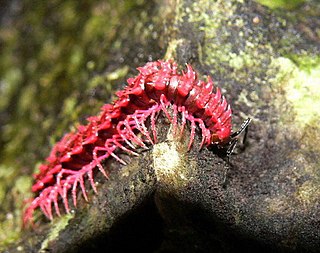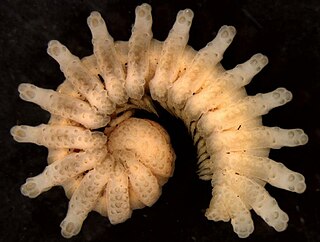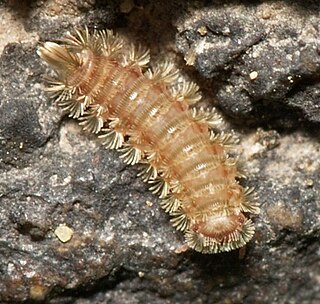
Spirostreptida is an order of long, cylindrical millipedes. There are approximately 1000 described species, making Spirostreptida the third largest order of millipedes after Polydesmida and Chordeumatida.

Desmoxytes, whose species are commonly known as the dragon millipedes, is a genus of millipedes of the family Paradoxosomatidae found in Southeast Asia. The genus was described by Ralph Vary Chamberlin in 1923, and reviewed by Sergei Golovatch and Henrik Enghoff in 1994. At least 18 species are known from to Malaysia, Myanmar, and Thailand. One species, D. planata, has also been observed in Sri Lanka, the Andaman Islands, Seychelles, Java, Great Coco Island, and Fiji; however, this species has expanded its range by being transported through human activity. Several species have only recently been discovered, and some have yet to be officially described.
Desmoxytoides hasenpuschorum is a species of millipede and the only species in the monotypic genus Desmoxytoides. It lives in Australia. This species is closely related to the dragon millipedes of the genus Desmoxytes, and there is some speculation, even by Robert Mesibov, the genus authority, that the split may not be necessary. While Desmoxytoides hasenpuschorum is similar to the millipedes of Desmoxytes in paranotal form and metatergite sculpture, it has a simpler gonopod telopodite with an unprotected solenomere which gives it its own monotypic genus. This species has the ability to produce hydrogen cyanide to ward off predators.

Polydesmida is the largest order of millipedes, containing approximately 3,500 species, including all the millipedes reported to produce hydrogen cyanide (HCN). Polydesmids grow and develop through a series of moults, adding segments until they reach a fixed number in the adult stage, which is usually the same for a given sex in a given species, at which point the moulting and the addition of segments and legs stop. This mode of development, known as teloanamorphosis, distinguishes this order from most other orders of millipedes, which usually continue to moult as adults, developing through either euanamorphosis or hemianamorphosis.

Eutrichodesmus is a genus of millipedes in the family Haplodesmidae, containing at least 32 species in China, Taiwan, and Southeast Asia. One of these species exhibits sexual dimorphism in segments number: The adult females have 20 segments, but the adult males have only 19.

Polyxenida is an order of millipedes readily distinguished by a unique body plan consisting of a soft, non-calcified body ornamented with tufts of bristles – traits that have inspired the common names "bristly millipedes" or "pincushion millipedes". There are at least 86 species in four families worldwide, and are the only living members of the subclass Penicillata.

Glomeridesmida is an order of millipedes in the infraclass Pentazonia containing 2 families and at least 31 species. Glomeridesmida is the only living order of the superorder Limacomorpha. Also known as slug millipedes, glomeridesmidans are small and somewhat flattened, and unlike other orders of Pentazonia, are unable to roll into a ball. Ocelli (eyes) are absent.

Dalodesmidae is a family of millipedes in the order Polydesmida, containing at least 250 species found in the Southern Hemisphere.

Chordeumatida is a large order of millipedes containing some 1200 species with a nearly worldwide distribution. Also known as sausage millipedes, they grow and develop through a series of moults, adding segments until they reach a fixed number in the adult stage, which is usually the same for a given sex in a given species, at which point the moulting and the addition of segments and legs stop. This mode of development, known as teloanamorphosis, distinguishes this order from most other orders of millipedes, which usually continue to moult as adults, developing through either euanamorphosis or hemianamorphosis.

Casimir Albrecht Willem Jeekel (1922–2010) was a Dutch myriapodologist and entomologist known for his major contributions to the taxonomy of millipedes. His 1971 monograph Nomenclator Generum et Familiarum Diplopodorum is credited as launching the "modern era" of millipede taxonomy, and has been considered the "most important single work ever published on the Diplopoda". He served as director of the Zoological Museum Amsterdam, and authored over 150 works on the taxonomy of millipedes and other myriapods.

The moss millipede is a keeled millipede of the family Platyrhacidae native to Colombia. It was described in 2011, and with several species of symbiotic moss found growing on its dorsal surface, it is the first millipede known with epizoic plants.

Platyrhacidae is a family of polydesmidan millipedes distributed in Southeast Asia and tropical Central and South America.

Psammodesmus is a genus of platyrhacid millipedes found from Panama to Peru. The 11 species constitute the platyrhacid subfamily Psammodesminae.

Haplodesmidae is a family of millipedes in the order Polydesmida. Species occur in East Asia, Southeast Asia, and Oceania, although some species have been introduced to the New world tropics. Species are small bodied, often with elaborate sculpturing on the tergites, and some species are capable of rolling into a near-complete ball.

Ammodesmidae is a family of small millipedes endemic to Africa, containing seven species in two genera. Ammodesmids range from 1.4 to 5.0 mm long with 18 or 19 body segments in both sexes, and are capable of rolling into a tight sphere.
Hylomus rhinoparvus is a species of dragon millipede in the family Paradoxosomatidae. It is only known from Houaphanh Province of northeastern Laos.

Anoplodesmus saussurii is a species of millipedes in the family Paradoxosomatidae. It was once thought endemic to Sri Lanka, but it was later found in Fiji and Mauritius.
Leptodesmus thwaitesii, is a species of millipedes in the family Chelodesmidae. It was once thought endemic to Sri Lanka, where first documented from Peradeniya.

Desmoxytes planata, is a species of millipedes in the family Paradoxosomatidae. It is a pantropical species with a vast distribution due to human interference in transportation. It is native to Andaman Islands and introduced to Thailand, the Seychelles, Java, Sri Lanka, Fiji and probably in Malay Peninsula.

Chelodesmidae, is a millipede family of order Polydesmida. The family includes 219 genera. Two new genera were described in 2012.














